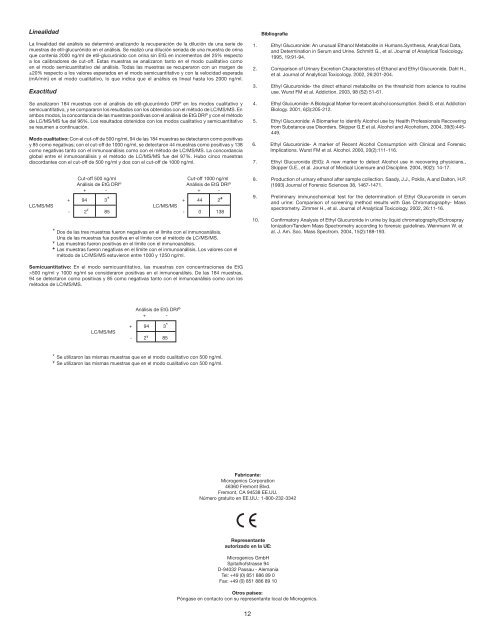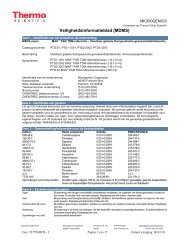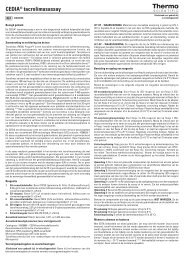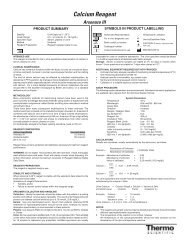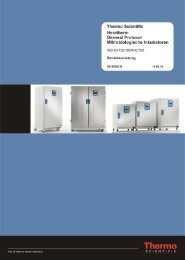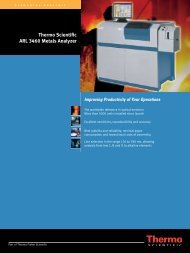DRI® Ethyl Glucuronide Assay - Fisher Scientific
DRI® Ethyl Glucuronide Assay - Fisher Scientific
DRI® Ethyl Glucuronide Assay - Fisher Scientific
You also want an ePaper? Increase the reach of your titles
YUMPU automatically turns print PDFs into web optimized ePapers that Google loves.
Linealidad<br />
La linealidad del análisis se determinó analizando la recuperación de la dilución de una serie de<br />
muestras de etil-glucurónido en el análisis. Se realizó una dilución seriada de una muestra de orina<br />
que contenía 2000 ng/ml de etil-glucurónido con orina sin EtG en incrementos del 25% respecto<br />
a los calibradores de cut-off. Estas muestras se analizaron tanto en el modo cualitativo como<br />
en el modo semicuantitativo del análisis. Todas las muestras se recuperaron con un margen de<br />
±20% respecto a los valores esperados en el modo semicuantitativo y con la velocidad esperada<br />
(mA/min) en el modo cualitativo, lo que indica que el análisis es lineal hasta los 2000 ng/ml.<br />
Exactitud<br />
Se analizaron 184 muestras con el análisis de etil-glucurónido DRI ® en los modos cualitativo y<br />
semicuantitativo, y se compararon los resultados con los obtenidos con el método de LC/MS/MS. En<br />
ambos modos, la concordancia de las muestras positivas con el análisis de EtG DRI ® y con el método<br />
de LC/MS/MS fue del 96%. Los resultados obtenidos con los modos cualitativo y semicuantitativo<br />
se resumen a continuación.<br />
Modo cualitativo: Con el cut-off de 500 ng/ml, 94 de las 184 muestras se detectaron como positivas<br />
y 85 como negativas; con el cut-off de 1000 ng/ml, se detectaron 44 muestras como positivas y 138<br />
como negativas tanto con el inmunoanálisis como con el método de LC/MS/MS. La concordancia<br />
global entre el inmunoanálisis y el método de LC/MS/MS fue del 97%. Hubo cinco muestras<br />
discordantes con el cut-off de 500 ng/ml y dos con el cut-off de 1000 ng/ml.<br />
Cut-off 500 ng/ml Cut-off 1000 ng/ml<br />
Análisis de EtG DRI ® Análisis de EtG DRI ®<br />
+ - + -<br />
+ 94 3 * + 44 2 ♠<br />
LC/MS/MS LC/MS/MS<br />
- 2 ¥ 85 - 0 138<br />
* Dos de las tres muestras fueron negativas en el límite con el inmunoanálisis.<br />
Una de las muestras fue positiva en el límite con el método de LC/MS/MS.<br />
¥ Las muestras fueron positivas en el límite con el inmunoanálisis.<br />
♠ Las muestras fueron negativas en el límite con el inmunoanálisis. Los valores con el<br />
método de LC/MS/MS estuvieron entre 1000 y 1250 ng/ml.<br />
Semicuantitativo: En el modo semicuantitativo, las muestras con concentraciones de EtG<br />
>500 ng/ml y 1000 ng/ml se consideraron positivas en el inmunoanálisis. De las 184 muestras,<br />
94 se detectaron como positivas y 85 como negativas tanto con el inmunoanálisis como con los<br />
métodos de LC/MS/MS.<br />
LC/MS/MS<br />
Análisis de EtG DRI ®<br />
+ -<br />
+ 94 3*<br />
- 2 ¥ 85<br />
* Se utilizaron las mismas muestras que en el modo cualitativo con 500 ng/ml.<br />
¥ Se utilizaron las mismas muestras que en el modo cualitativo con 500 ng/ml.<br />
12<br />
Bibliografía<br />
Fabricante:<br />
Microgenics Corporation<br />
46360 Fremont Blvd.<br />
Fremont, CA 94538 EE.UU.<br />
Número gratuito en EE.UU.: 1-800-232-3342<br />
Representante<br />
autorizado en la UE:<br />
Microgenics GmbH<br />
Spitalhofstrasse 94<br />
D-94032 Passau - Alemania<br />
Tel: +49 (0) 851 886 89 0<br />
Fax: +49 (0) 851 886 89 10<br />
Otros países:<br />
Póngase en contacto con su representante local de Microgenics.<br />
1. <strong>Ethyl</strong> <strong>Glucuronide</strong>: An unusual Ethanol Metabolite in Humans.Synthesis, Analytical Data,<br />
and Determination in Serum and Urine. Schmitt G., et al. Journal of Analytical Toxicology.<br />
1995, 19:91-94.<br />
2. Comparison of Urinary Excretion Characteristics of Ethanol and <strong>Ethyl</strong> <strong>Glucuronide</strong>. Dahl H.,<br />
et al. Journal of Analytical Toxicology. 2002, 26:201-204.<br />
3. <strong>Ethyl</strong> <strong>Glucuronide</strong>- the direct ethanol metabolite on the threshold from science to routine<br />
use. Wurst FM et al. Addiction. 2003, 98 (S2) 51-61.<br />
4. <strong>Ethyl</strong> <strong>Glucuronide</strong>- A Biological Marker for recent alcohol consumption. Seidi S. et al. Addiction<br />
Biology. 2001, 6(3):205-212.<br />
5. <strong>Ethyl</strong> <strong>Glucuronide</strong>: A Biomarker to identify Alcohol use by Health Professionals Recovering<br />
from Substance use Disorders. Skipper G.E et al. Alcohol and Alcoholism, 2004, 39(5):445-<br />
449.<br />
6. <strong>Ethyl</strong> <strong>Glucuronide</strong>- A marker of Recent Alcohol Consumption with Clinical and Forensic<br />
Implications. Wurst FM et al. Alcohol. 2000, 20(2):111-116.<br />
7. <strong>Ethyl</strong> <strong>Glucuronide</strong> (EtG): A new marker to detect Alcohol use in recovering physicians.,<br />
Skipper G.E., et al. Journal of Medical Licensure and Discipline. 2004, 90(2): 14-17.<br />
8. Production of urinary ethanol after sample collection. Saady, J.J., Poklis, A.and Dalton, H.P.<br />
(1993) Journal of Forensic Sciences 38, 1467-1471.<br />
9. Preliminary immunochemical test for the determination of <strong>Ethyl</strong> <strong>Glucuronide</strong> in serum<br />
and urine: Comparison of screening method results with Gas Chromatography- Mass<br />
spectrometry. Zimmer H., et al. Journal of Analytical Toxicology. 2002, 26:11-16.<br />
10. Confirmatory Analysis of <strong>Ethyl</strong> <strong>Glucuronide</strong> in urine by liquid chromatography/Elctrospray<br />
Ionization/Tandem Mass Spectrometry according to forensic guidelines. Weinmann W. et<br />
al. J. Am. Soc. Mass Spectrom. 2004, 15(2):188-193.


